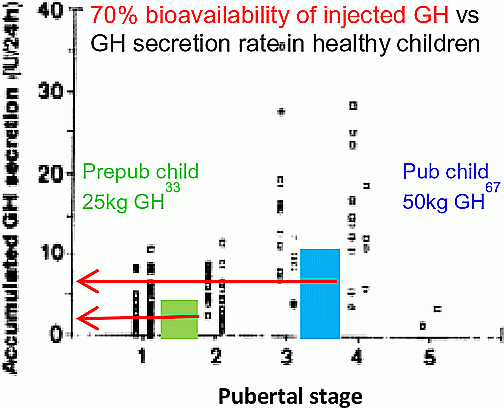ESPE2016 Poster Presentations Growth P1 (48 abstracts)
Are the GH Treatment Doses in Use within Secretion Rates of Healthy Children?
Elena Lundberg a , Bjorn Andersson a , Berit Kristrom a , Sten Rosberg b & Kerstin Albertsson-Wikland b
aInstitute of Clinical Science/Pediatrics, Umeå Univesity, Umea SE-90185, Sweden; bDepartment of Physiology/Endocrinology, Institute of Neurosciences and Physiology, The Sahlgrenska Academy at University of Gothenburg, Gothenburg SE-40530, Sweden
Background: GH-secretion rates for children ranges in pre/early puberty 0.1–11 U/24 h and during mid-puberty 4–40 U/24 h. This can be used to optimize the rhGH treatment doses in children.
Objective and hypotheses: To calculated the bioavailable rhGH in relation to injected dose and compare this to GH-secretory rate in healthy children; and to investigate factors influencing bioavailability.
Method: One hundred and twenty eight children were followed yearly ≤8 years for GH-curves after deep sc injection with 12 mm needle, GH33/GH67μg/kg. EXPerimental setting (59 GH-curves in 15 MPHD patients) and CLINical setting (154 GH-curves in 117 IGHD/ISS patients). The cumulative amount of GH was estimated by our formula (1), compared with the injected dose (U)=100% which gives the bioavailability (%).
Results: Bioavailability (median %, coefficient of the variation %) in EXP became 84%(35), range 0–100% with positive GH-concentration dependency,16 vs 4 IU/ml, P=0.035. In CLIN, bioavailability was 71(43), range 0–100%, without GH-dose dependency, P=0.21. Twenty-two percent of the variation was explained by the depth of injection estimated by GHpeakwidth, BMISDS and GH-level at baseline. Consequence for GH-dosing: i.e. in a prepubertal 25 kg child GH33gives 2.5 U/24 h (70%=1.75 U/24 h); in pubertal 50 kg child GH67 gives10 U/24 h (70%=7 U/24 h).
Conclusion: The uptake of injected GH33 GH67 was around 70% with great variation influenced by injection-depth. Bioavailable GH will therefore, correspond to secretion rates in lower range of healthy children.

 }
}



